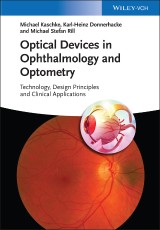Details

Optical Devices in Ophthalmology and Optometry
Technology, Design Principles and Clinical Applications1. Aufl.
|
151,99 € |
|
| Verlag: | Wiley-VCH |
| Format: | |
| Veröffentl.: | 25.11.2013 |
| ISBN/EAN: | 9783527648993 |
| Sprache: | englisch |
| Anzahl Seiten: | 638 |
DRM-geschütztes eBook, Sie benötigen z.B. Adobe Digital Editions und eine Adobe ID zum Lesen.
Beschreibungen
<b>Optical Devices in Ophthalmology and Optometry</b> <p>Medical technology is a fast growing field. <i>Optical Devices in Ophthalmology and Optometry</i> gives a comprehensive review of modern optical technologies in ophthalmology and optometry alongside their clinical deployment. It bridges the technology and clinical domains and will be suitable in both technical and clinical environments. The book introduces and develops basic physical methods (in optics, photonics, and metrology) and their applications in the design of optical systems for use in ophthalmic medical technology. Medical applications described in detail demonstrate the advantage of utilizing optical-photonic methods. Exercises and solutions for each chapter help understand and apply basic principles and methods. <p><b>From the contents:</b> <ul><li>Structure and Function of the Human Eye</li><li>Optics of the Human Eye</li><li>Visual Disorders and Major Eye Diseases</li><li>Introduction to Ophthalmic Diagnosis and Imaging</li><li>Determination of the Refractive Status of the Eye</li><li>Optical Visualization, Imaging, and Structural Analysis</li><li>Optical Coherence Methods for Three-Dimensional Visualization and Structural Analysis</li><li>Functional Diagnostics</li><li>Laser???Tissue Interaction</li><li>Laser Systems for Treatment of Eye Diseases and Refractive Errors</li></ul>
PART I<br> 1. Structure and Function<br> 2. Optics of the Human Eye<br> 3. Visual Disorders and Major Eye Diseases<br> PART II<br> 4. Introduction to Ophthalmic Diagnosis and Imaging<br> 5. Determination of the Refractive Status of the Eye<br> 6. Optical Visualization, Imaging, and Structural Analysis<br> 7. Optical Coherence Methods for Three-Dimensional Visualization and Structural Analysis<br> 8. Functional Diagnostics<br> PART III<br> 9. Laser-Tissue Interaction<br> 10. Laser Systems for Treatment of Eye Diseases and Refractive Errors<br> PART IV<br> A. Basics of Optics<br> B. Basics of Laser Systems<br> C. Used Variables and Abbreviations<br>
<p>“This unique and timely compendium is an excellent way to stay on top. It is written in a manner that makes the technology and corresponding clinical applications understandable, even for those with limited technical knowledge.” (<i>Doody’s</i>, 2 October 2015)</p> <p>“Optical Devices in Ophthalmology and Optometry is a timely, highly readable, and beautifully illustrated text that fulfills the need to bridge technical and clinical optics. In whole or part, it is an invaluable reference or basic text for Optometry, Ophthalmology, and Vision Science.” (<i>Optometry & Vision Science</i>, 1 May 2015)</p> <p>“The book is clearly written with many excellent illustrations.” (<i>Optics and Photonics News</i>, 31 October 2014)</p> <p>“Optical Devices in Ophthalmology and Optometry sets a very high standard for biomedical optics textbooks. I am impressed with the integration of the mathematical physics, the explanations of the fundamental physics with the emphasis on physical insights, the instrument design principles and their relation to the function of resulting medical device, and the clear explanations of the coupling between the optical properties of the eye and the coupling with the optical devices.” (<i>Journal of Biomedical Optics</i>, 1 July 2014)</p> <p> </p>
<p><i><b>Michael Kaschke</b> received his Ph.D. degree from the Friedrich Schiller University of Jena in 1986 for his research in the field of ultra-short light pulses and ultrafast spectroscopy. Before joining Carl Zeiss, he was a research scientist at Max-Born-Institute Berlin, Max-Planck-Institute G??ttingen, and invited visiting scientist at IBM Research Center York- town Heights, N.Y., working on high-power fs-laser pulses and their matter interaction. He joined the Carl Zeiss Group in 1992 and has held since then several research and management positions in the company, predominantly in the medical business. Michael Kaschke is currently President and CEO of the Carl Zeiss Group, a technology leader in optics, optoelectronic, and medical tech- nology headquartered in Oberkochen, Germany. He is also a professor for medical technology at the Karlsruhe Institute of Technology, Germany.</i></p> <p><i><b>Karl-Heinz Donnerhacke</b> received his Ph.D. degree from the Friedrich Schiller University of Jena, Germany, in 1976 for his research in the field of high power gas lasers. He spent over 25 years of his professional career working at Carl Zeiss in laser development and laser application in medicine. Until his retirement he was Director of R&D in the Ophthalmic Diagnostic Instruments Division of Carl Zeiss/Carl Zeiss Meditec for almost 20 years. Since 2003, Karl-Heinz Donnerhacke has been an adjunct professor for ophthalmic technology at the Ernst Abbe University of Applied Sciences Jena, Germany and the Technical University Ilmenau, Germany. Currently he also works as a technology consultant in the field of ophthalmic devices.</i> <p><i><b>Michael Stefan Rill</b> received his Ph.D. degree from the Institute of Applied Physics at the Karlsruhe Institute of Technology, Germany, in 2010 for his research in the field of 3D photonic metamaterials. He joined Carl Zeiss in Oberkochen, Germany as a scientific assistant to the CEO in 2010. In 2013 Michael Stefan Rill assumed the position of product manager for cataract surgery systems at Carl Zeiss in Jena, Germany.</i>
<p>Medical technology is a fast growing field. <i>Optical Devices in Ophthalmology and Optometry</i> gives a comprehensive review of modern optical technologies in ophthalmology and optometry alongside their clinical deployment. It bridges the technology and clinical domains and will be suitable in both technical and clinical environments. The book introduces and develops basic physical methods (in optics, photonics, and metrology) and their applications in the design of optical systems for use in ophthalmic medical technology. Medical applications described in detail demonstrate the advantage of utilizing optical-photonic methods. Exercises and solutions for each chapter help understand and apply basic principles and methods.</p> <p><b>From the contents:</b> <ul><li>Structure and Function of the Human Eye</li><li>Optics of the Human Eye</li><li>Visual Disorders and Major Eye Diseases</li><li>Introduction to Ophthalmic Diagnosis and Imaging</li><li>Determination of the Refractive Status of the Eye</li><li>Optical Visualization, Imaging, and Structural Analysis</li><li>Optical Coherence Methods for Three-Dimensional Visualization and Structural Analysis</li><li>Functional Diagnostics</li><li>Laser???Tissue Interaction</li><li>Laser Systems for Treatment of Eye Diseases and Refractive Errors</li></ul>

















